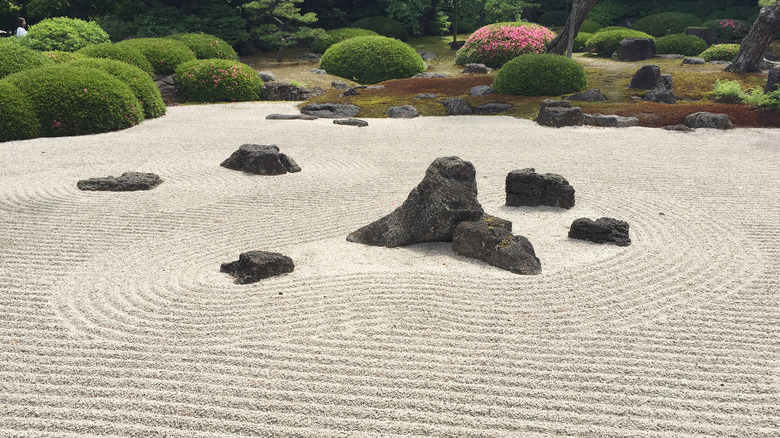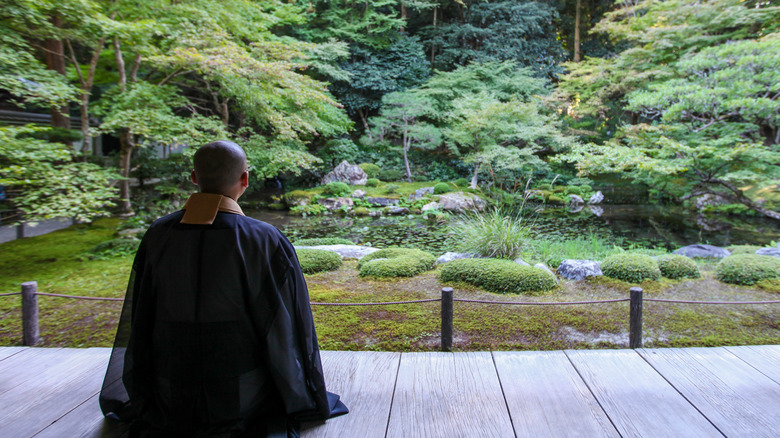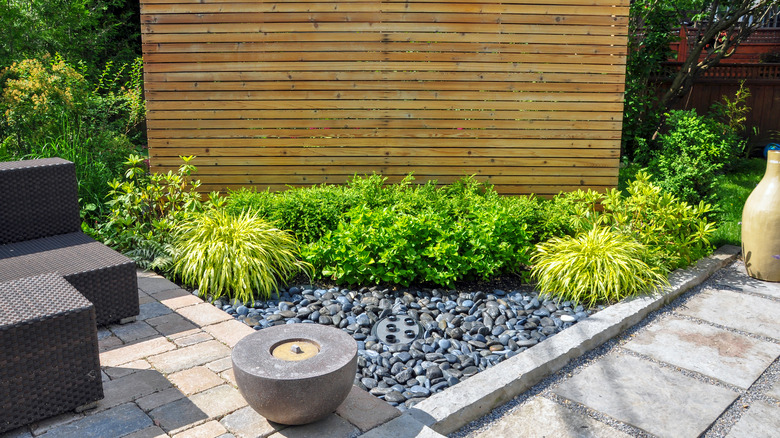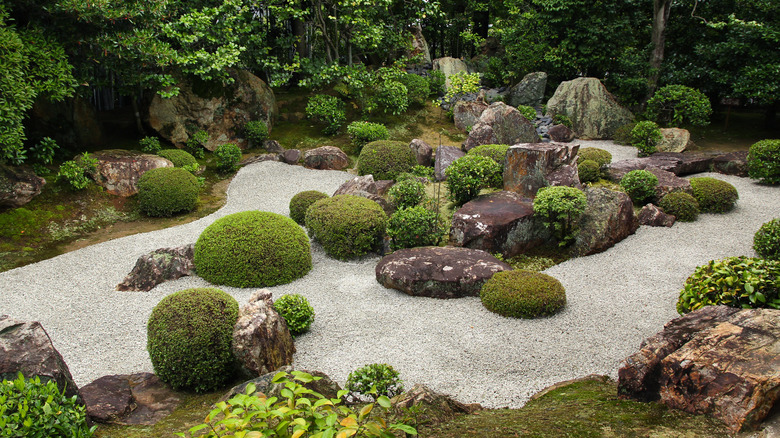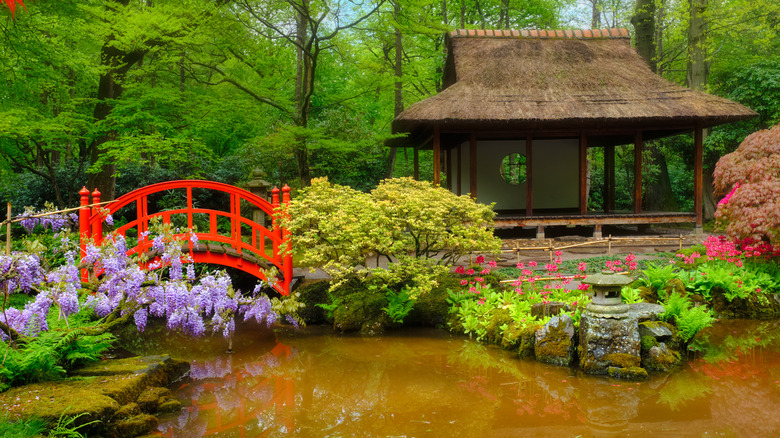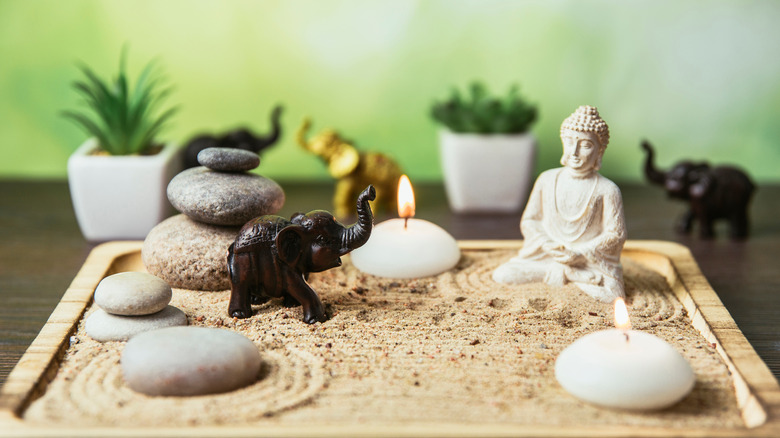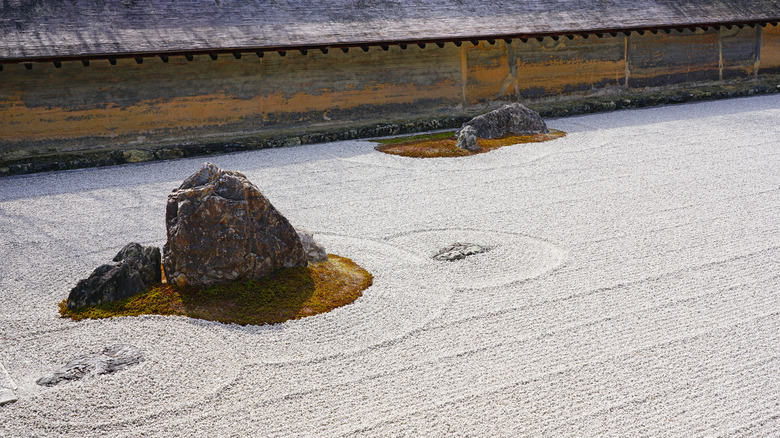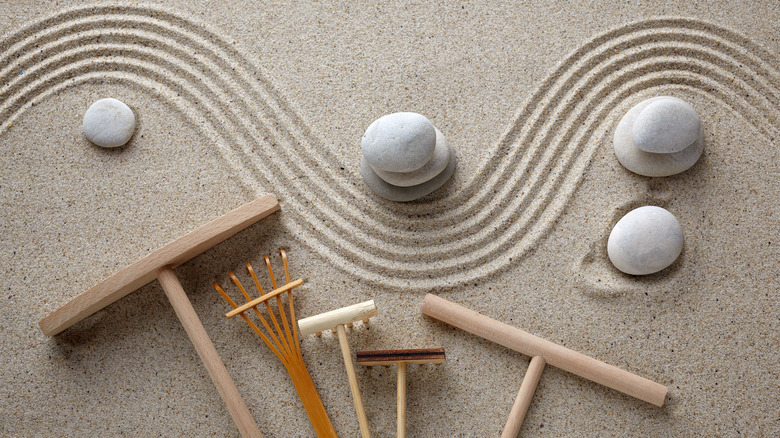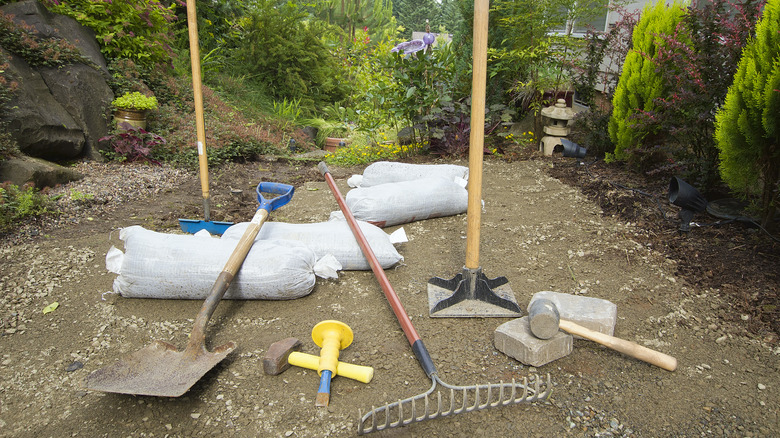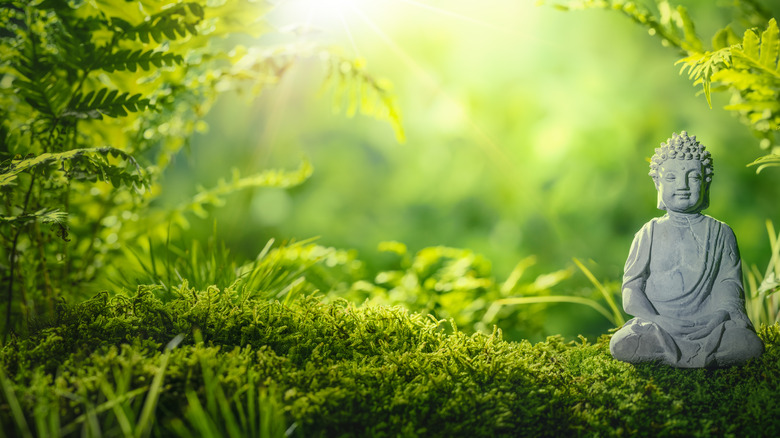What Is A Zen Garden And What Makes Them Different?
Your home garden might include a variety of flowers, plants, trees, and herbs, among other aesthetic elements. But if you want to create a Zen garden, you will need to hone in on its focused purpose and enlightened design. Dating back approximately 2,500 years, the first Zen gardens, or Japanese rock gardens, were inspired by an Indian man named Siddhartha Guatama and his journey of enlightenment. Zen gardens were established upon his transformation into the Buddha, highly influencing Japanese culture. The word "zen" is often associated with the act of meditation, which includes personal mindfulness and reflection, and is considered a transcendent experience.
These days, Zen gardens are popular because of their simplicity and tranquility. The rock gardens are undoubtedly low maintenance compared to the upkeep of plant life. In addition, raking the sand and gravel is a relaxing, thoughtful practice. Zen rock gardens, or karesansui (translated as "dry-mountain-water"), originated in Japan during medieval times, and the most famous example is located in Kyoto, Japan (via Japan Guide). If you want to try creating your own Zen garden, here is everything you need to know about them.
What is a Zen garden?
Designed for the mind, Zen gardens create a calm, meditative place for those who enter it. Originally, Zen gardens were dry landscapes, with stones being the most important subjects presented. The landscape signifies four elements: mountains, trees, water, and fire. The stones are deliberately placed irregularly to represent an abstract seashore or river. Depending on how the rocks are arranged, they are intended to resemble flowing water. The garden's imagery promotes a balance between the sensations of eternity and vacancy to empty the matters of the mind.
Initially, the purpose of a Zen garden was to be a space for Buddhist monks to meditate and ponder the teachings of the Buddha, but you don't have to be a Zen Buddhist to have one. These days, modern Japanese gardens are made to be a place of tranquility and reflective meditation and can be included anywhere from a backyard to an office.
Why do you need a Zen garden?
Why should you create a Zen garden? Imagine mountains and water. The imagery of these natural wonders projects tranquil feelings that enrich the soul. These artful rock gardens take introspection a step further with the art of representation. Every aspect has a purpose, as rocks and sand help the spectator gain perspective. The more you rake in the garden, the more it will contribute to a better sense of wholeness, as well as opening your creative mind. Throughout this mindful practice, new ideas may surge while simultaneously obstructing unwanted thoughts, notes Medium.
Over time, maintaining your Zen concentration will also provide opportunities to reposition the pieces within the garden as a means of artistic self-expression. If you're a homeowner and thinking about putting your house on the market someday, a Zen garden is a great selling point for potential buyers, per Everything Backyard. They can easily envision themselves in this relaxing, inviting space, whether to meditate or entertain in. While designing your garden, consider your environment, location, and layout. This is a distinctive aspect to add to your property.
How to use a Zen garden
Japanese rock gardens should be an oasis, free from distraction, made specifically for meditation and putting your mind at ease. Stillness is a strength often expressed through the placement and presence of the rocks. The gravel conveys a sense of calm through motionless ripple-like patterns. Some vegetation like moss or lichen is acceptable to use along with specimen plants that can add color or texture. You might include some moss or pruned shrubs as accents, but nothing that would spread to a larger degree. If planting, also consider how much sun the plants will need to receive in the garden.
Initially featured in many Japanese temples, Zen gardens are now designed for private meditative backyard spaces or other work environments. From big to small, they can transform a variety of places into helping find your Zen. Use crushed granite, fine gravel, or small pebbles to spread across your garden so you can rake them into various composed designs. For certified privacy, include an enclosure to surround your Zen space, such as a flanked bamboo screen or a stone or wooden wall.
Find your Zen garden style
Once you've established the perfect location for your Zen garden, envision exactly how you want it to look and what elements are essential to include. Design and draw your own rough sketch or hire a professional landscape designer to achieve your vision. According to Dengarden, many Zen gardens are structured around seven design rules: austerity, simplicity, naturalness, asymmetry, subtlety, unconventionalness, and stillness.
For a balanced meditation garden, keep these concepts in mind during the design process. You might want to develop more space, add art pieces, statues, or a seating area as well as a bridge. Browse various Japanese rock gardens before establishing a design but keep it simple. Stones are one of the most prominent tools within the structure. The different ways they can be formed are boundless. Each formation exemplifies various elements: air, earth, fire, metal, and water. Vertically positioned stones symbolize trees, while horizontal ones suggest water. Stones that appear in an arched format signify fire. You could also include a pathway or bridge constructed of rocks or stones, which gives your landscape visual depth, notes Gardening Know How. Utilizing focal points will support your thoughtful design.
How to create a Zen garden
Installing a Zen Garden has many therapeutic benefits. It is designed for meditation while utilizing rocks, gravel, sand, and wood. Traditionally, very few plants and water elements are implemented. Instead, you might rake and shape the sand (or gravel) into formations representing ocean waves' motion and texture, thus, symbolizing water, notes Home Depot. A larger stone or rock is typically featured to represent a solid, fixed mountain with the waterlike ripples visible around it. This designates a balance between the yin and yang.
Choose a flat, even site for your rock garden that will suit your meditative style. If uneven, rake the ground to remove any leaves, roots, stones, or other unwanted debris. Decide where your rocks or plants will go and dig holes for them. Rocks should be strategically placed to achieve your optimum Zen. Once the soil is firm, install landscape fabric over the area; cut holes where items will reside. This will ensure the foundation and discourage weed growth. Asymmetry is another valid component of a harmonious Zen design. Objects are often displayed in groups of three, as in the Buddhist trinity. Using just a few large rocks is enough to balance your garden.
Types of Japanese rock gardens
You can experience Japanese gardens by either walking around them or enjoying them from a distance, like on a porch or bridge. Altogether, there are five types of Japanese garden styles. According to the Japanese Garden Society, they are:
- Pond and island – The oldest style in Japan, this garden usually has a sacred island in the center with bridges connecting to it.
- Dry landscape – Gravel is often raked in numerous ways to represent water.
- Tea Garden – The tea garden path, or Roji, leads you from the outside world to a rustic teahouse using steppingstones.
- Stroll – Intended for visitors to walk or stroll around it, it is typically centered around a large pond.
- Courtyard – These quaint gardens are found in smaller nooks, including in between building spaces or small courtyards in homes.
Also, if you need daily stress relief at work, consider creating a mini Zen garden for your desk or counter. Fill a shallow planter with sand and add your desired elements. If you want to add some decorative plant life, include a small succulent, per Home Depot. Keep it in its original container and place it on the sand. Then, include a few small pebbles along with a little garden rake. Raking your tension away at the office will calm your mind naturally.
Materials for your garden
Few items are necessary when designing a rock garden (stones, gravel/sand, and wood), yet all depends upon your vision with the size you choose and how intricate you want it to be. When using gravel for ocean waves or ripples in a pebble pond, get creative beyond the norm. Experts at SF Gate suggest using flat river rocks as larger points of interest, including white landscaping rocks (resembling snow) and perhaps other colored rocks. Larger Japanese rocks or stones will work for your mountain/island markers. Gravel plays an essential role in the establishment of your Zen garden. The raking process alone provides the participant a meditative experience, including improved mental and spiritual focus. Use a wide-toothed rake to comb your finely crushed gravel, pea-sized gravel, or small pebbles. Sand can also be used, but gravel is sturdier and lasts longer.
Traditionally, wood is represented in the garden with benches, bridges, or screening. Many wooden or stone pieces are used instead of metal or plastic, whether manufactured or handmade. This keeps the garden's association with nature, SF Gate notes. If you desire to include some vegetation, moss is commonly used to embody the image of islands. Moss requires little maintenance with light soil and low light. Keep it damp without overwatering. Additionally, various lighting is another option to enhance your garden. Illuminate pathways and other important objects with lanterns.
How to care for your Zen garden
Much of the practice of caring for your Zen garden comes from the realization that you're taking care of yourself as well. This comes from raking the gravel or sand. Repetitive motions of designing circles, waves, or other forms are a positive way to calm the mind, establish attentiveness, and cultivate personal discipline.
Besides focusing on the mental aspects of care, your Zen garden will need regular maintenance from time to time as well. Consider rainfall, foot traffic, and other interferences like weeds that need to be maintained. To keep it looking tidy, clean up leaves, branches, debris, and weeds. Shape your shrubs and moss if required. In addition, all the care and maintenance you put into your Japanese garden project reflects largely upon your wellness, per Garden Design. Ensure the area of your garden is well-draining, as the filter and pipes should be maintained. According to Green and Prosperous, drainpipes can get clogged with small pebbles or other debris after heavy rain or weather and should be inspected frequently.
How much will your rock garden cost?
The cost of your Zen garden depends upon how large or small you envision it to be. You could spend between a few hundred to a few thousand dollars. You might purchase numerous authentic pieces from Japan or keep your rock garden less elaborate and more economical. To start, create a budget. Bigger gardens will require lots more sand, rocks, and tarp materials. According to eHow, white sand is offered at most pet stores (for saltwater aquariums), while larger amounts might be available at home improvement stores and garden centers, including discounted bags of gravel. Instead of purchasing pricey water features, expensive amounts of stones, or greenery, focus on one item to become the main focus.
Overall, by keeping it simple, you will acknowledge the level of Zen that your garden requires. If you decide to implement moss, you might consider transplanting some from a local forested area. Otherwise, it can be purchased from a local garden center or home improvement store. Prices may range from $4 to $10 per square foot, per HGTV. Also, landscape fabric will vary depending on the company you purchase it from. Still, on average, it might cost $110 to $180 (ranging from basic to best), not including installation fees, per Remodeling Expense.
Are Zen gardens safe?
Before installing your Zen garden, be mindful of how the pets and children in your life will react to it. If you have a dog that likes to dig in the sand, you might need to keep it completely closed off with a private entrance. As you maintain your Zen garden, it may not suit your children's activity levels, although they might enjoy raking or combing the sand, suggests The Spruce Crafts. Nevertheless, take care of your garden the way you choose, keeping in mind that it should remain a place of peace and refuge.
If you have a lot of foliage and moss, you might be wary of your pets possibly ingesting some. Japanese moss (Selaginella kraussiana) is considered non-toxic to humans, cats, dogs, and horses, but everyone has a different reaction to things. While moss is also not considered harmful to your garden or lawn, it may be susceptible to potential drainage issues, as it loves compact soil, shade, and moisture. Overall, moss is harmless and does not produce any bacteria or fumes.
